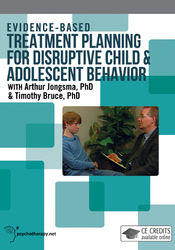 Psychotherapy.net continues to expand its library with additional videos and materials. In reviewing their streaming video on Evidence-Based Treatment Planning for Disruptive Child and Adolescent Behavior, I found the video to be comprehensive and informative. Drs. Timothy Bruce and Arthur Jongsma first focus on explaining the various definitions of behavioral disorders and their related literature. The focus of the video is on the disruptive behavior of the oppositional and conduct type. The viewer is also reminded that many disruptive behaviors can be included in a variety of disorders such as ADHD and ODD. Dr. Bruce then discusses a brief history of the movement to solidify empirically supported treatments (ESTs). One strong goal of the video, which is done well, is to “demonstrat[e] how a treatment plan can be empirically informed by incorporating goals, objectives, and treatment interventions that are consistent with evidence-based practices.” The first half of the hour-long video is dedicated to the education of counselors, and includes citing additional resources and literature that have had an impact on our understanding of counseling regarding disruptive behaviors. The authors also discuss the appropriate use of role modeling, school–counselor–parent interactions, and conflict management techniques. This comprehensive review of resources is given in combination with slide graphics, which highlight the main points to help the viewer gain a strong understanding of the material.
Psychotherapy.net continues to expand its library with additional videos and materials. In reviewing their streaming video on Evidence-Based Treatment Planning for Disruptive Child and Adolescent Behavior, I found the video to be comprehensive and informative. Drs. Timothy Bruce and Arthur Jongsma first focus on explaining the various definitions of behavioral disorders and their related literature. The focus of the video is on the disruptive behavior of the oppositional and conduct type. The viewer is also reminded that many disruptive behaviors can be included in a variety of disorders such as ADHD and ODD. Dr. Bruce then discusses a brief history of the movement to solidify empirically supported treatments (ESTs). One strong goal of the video, which is done well, is to “demonstrat[e] how a treatment plan can be empirically informed by incorporating goals, objectives, and treatment interventions that are consistent with evidence-based practices.” The first half of the hour-long video is dedicated to the education of counselors, and includes citing additional resources and literature that have had an impact on our understanding of counseling regarding disruptive behaviors. The authors also discuss the appropriate use of role modeling, school–counselor–parent interactions, and conflict management techniques. This comprehensive review of resources is given in combination with slide graphics, which highlight the main points to help the viewer gain a strong understanding of the material.
There are a number of clips that model how a counselor would work with parents, as well as with a teenage male, and which highlight how situations can be de-escalated while dealing with the negative behaviors in a positive manner. Techniques are first processed between the counselors and then role modeled through counseling sessions, either with the parents or the child. Following the role modeling sessions the counselors revisit the learning objectives for the section and discuss how they were illustrated through the role modeling. While some of the role-plays seem a little bit scripted, the material is presented in a realistic fashion so that the viewer can see a strong example of how theory, techniques, and practice combine to help clients make positive changes.
The program is well produced with a smooth flow between instruction and demonstration. It is in a video format that is visually clear with good sound, which is appropriate for viewing by an individual or for use with an entire class. One strength of the program is that the video is presented with a complete script, with the added capability of clicking on a word in the script and starting the video at the correlating spot. This capability allows for easy review and navigation throughout the video.
Overall, I would recommend this video as an introduction for beginning counselors-in-training or for professionals who want to review their understanding in this area. Online education has learned that hour-long videos are not the best for comprehension, yet with the Psychotherapy.net system a person can easily return to view the material in smaller sections. The use of these videos as a learning tool is strongly recommended and technology has now allowed us to access these materials easily and at a time of our choosing.
John Wiley & Sons, Inc. (Producer). (2011). Evidence-Based
Treatment Planning for Disruptive Child and Adolescent Behavior. (Available in video streaming fromhttps://www.psychotherapy.net/video/evidence-based-treatment-planning-child-behavior-problems)
Available in streaming format as part of video subscription at www.psychotherapy.net/subscriptions.
Reviewed by: Dr. Matthew Mims, NCC, University of Nebraska at Kearney.
The Professional Counselor
